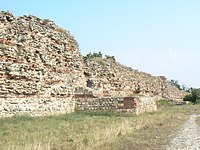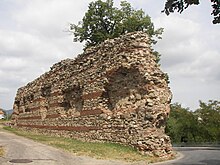Chissariah
| Chissarja (Хисаря) | |||
|
|||
| Basic data | |||
|---|---|---|---|
| State : |
|
||
| Oblast : | Plovdiv | ||
| Residents : | 6362 (December 31, 2018) | ||
| Coordinates : | 42 ° 30 ' N , 24 ° 42' E | ||
| Height : | 346 m | ||
| Postal code : | 4180 | ||
| Telephone code : | (+359) 0337 | ||
| License plate : | PB | ||
| administration | |||
| Mayor : | Georgi Piriankov | ||
Chissarja [ xiˈsarjɐ ] (Bulgar. Хисаря; often Hisarja or Hisar) is a city and administrative center of a municipality of the same name in southern Bulgaria . In the course of its history the city had different names (Thracian Havuz; Latin Augusta; Slavic Lica; Byzantine Diocletianopolis; Turkish Hisarya from the Persian حصار / Hesar for wall).
geography
Chissarja is located in Plovdiv Oblast near the city of Karlovo . Hissariah is the administrative center of the municipality of Hissariah. The city has a central location in Bulgaria. It is located on the southern foothills of the Balkan Mountains , at the transition to the Upper Thracian Plain .
climate
The climate here is temperate continental with warm and mild winters. There is an average of only 27 days of snow a year. Spring comes early and is relatively warm. Summer (July / August) is very hot with low humidity and weak winds. Autumn is sunny, warm and very long. The mean annual temperature is 11.5 ° C.
There are 22 thermal springs in the city with proven medicinal properties, concentrated in a small area, with different temperatures and chemical compositions.
The first organized balneotherapy in Bulgaria started in Chissarja. In 1882 the government of Eastern Rumelia issued a set of rules for the use of the Chissarja baths . The Czech chemist Sosterschonek analyzed the water from five springs in Chissarja in the laboratory of the health department in Plovdiv. It was the first chemical analysis of mineral water in Bulgaria.
history
The pleasant climate and warm mineral springs have drawn people to this place since ancient times. Already before 5000 to 6000 BC there were A prehistoric village. Later there was a Thracian settlement near the mineral springs, which belonged to the kingdom of the Thracian tribe of the Odrysen (Odrysen Empire; Bulgar. Одриска държава). Large Thracian cult institutions near Starosel date from this period.
After the conquest by the Roman Empire , the area belonged to the Roman province of Thrace . From 46 AD a large Roman settlement was built next to the springs, which was raised to the status of a city by Emperor Diocletian in 293 AD . The city was renamed Diocletianopolis. The city was immediately fortified with massive walls and a lot of building activity in the city. Today these city walls are still very well preserved. In many places the city wall reached a height of eleven meters. The southern city gate is even 13 m high.
Today these buildings are concentrated in the central city park "Momina Salsa" - with the source of the same name "Momina Salsa" (Bulgarian Момина сълза; German: Jungfrauenträne). This is also where the most magnificent public building stood - a two-story residence with impressive arches. The thermal baths of Diocletianopolis with an area of 2000 m² are in the immediate vicinity . They are one of the few surviving Roman baths on the Balkan Peninsula . Healing treatments with mineral water were carried out here. Except for the roof, the thermal baths are almost completely preserved. The interior of the thermal baths was clad with white marble. The thermal baths were heated with the hot mineral water. Next to the thermal baths is an amphitheater . In ancient times, the amphitheater was very popular and the favorite place of guests who came to the city for relaxation and entertainment. The amphitheater is laid out in the shape of a circus, where sports competitions and fights with wild animals took place. The amphitheater was built in the first half of the 4th century AD. The rule of the new Christian teaching that no blood should be shed was observed. The amphitheater and its facilities have been preserved in excellent condition.
After Christianity was introduced as the official religion of the Roman Empire ( Constantinian Turn ) in the first half of the 4th century AD, Diocletianopolis became an important Christian center and bishopric. Ten early Christian basilicas from the 4th to 6th centuries have been excavated in the city. The particular interest of archaeologists was the only excavated basilica with two naves , the center of the 5th century on parts of a barracks complex of the ancient city was built. Historical sources say that the city was the third largest city in the province of Thrace at the time - after Philopolis (now Plovdiv ) and Beroe (now Stara Sagora ).
After the invasions of the Goths , Avars and Slavs and the centuries of decay that followed, a new settlement was built on the ruins of the ancient and medieval buildings in the second half of the 17th century. The small village was called Chissarja, from the Arabic word for “fortress” Hisar.
The necropolis of Diocletianopolis is 300 m south of the city walls. The original has been preserved and is accessible to visitors. The long corridors, the burial chambers and the colorful floor mosaics are impressive.
Bogdan Filow began the historical excavations in Chissarja in 1909 and was director of the local folklore museum from 1910 to 1920.
The city has been namesake for Hisarya Cove , a bay on the southeast coast of Smith Island in Antarctica , since 2008 .
religion
Since the city was at a historical junction, it was home to many beliefs and religions - starting with the ancient Thracian mysteries and Orphics , through the early Christian basilicas up to our day.
Today there are three Orthodox, two Catholic and one Protestant churches as well as a mosque in the city.
The Sveti Panteleemon Orthodox Church (Bulgarian Свети Пантелеймон) is located in the city center. It was built in 1889. Its wall paintings, which reproduce almost all biblical stories, should be emphasized. They were drawn by local artists - in the style of the wall paintings of the Rila monastery . The patron saint of the Church, Saint Pantelejmon, is the protector of the sick. It is celebrated on July 27th every year.
The other Orthodox churches are Uspenie Bogorodiza (bulg. Успение Богородично) and Sweti Dimitar (bulg. Свети Димитър).
The mosque is over 400 years old and is located near the western city gate. It was built when Chissarja was a Turkish settlement during the Turkish rule. During the Russo-Turkish War (1877–1878) the mosque was burned down; to this day only the minaret remains.
The titular diocese of Diocletianopolis still exists in Thracia today .
Museums
The local archaeological museum was founded by General Todor Markov. It contains an extensive collection of archaeological and ethnographic finds. There are excellently preserved prehistoric pieces, Thracian, Roman and Byzantine vessels, marble slabs and statues, coins made of gold, silver and bronze that show the history of the peoples who settled in this region.
The Momina Banja spa (Bulgarian Момина баня) has had a collection of over 10,000 kidney stones since 1981 , which patients and bathers lost after balneotherapy in Chissarja. A small part of it was removed by surgery - the largest stone weighs 560 g. The collection is proof of the healing properties of Chissarja mineral water.
Web links
Individual evidence
- ↑ Population by towns and sex. In: nsi.bg. Republic of Bulgaria - National Statistical Institute (NSI), April 12, 2019, accessed May 5, 2019 .




